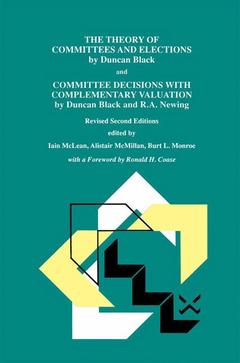Description
The Theory of Committees and Elections by Duncan Black and Committee Decisions with Complementary Valuation by Duncan Black and R.A. Newing (2nd Ed., Softcover reprint of the original 2nd ed. 1998)
Coordinators: McLean Iain S., McMillan Alistair, Monroe Burt L.
Language: English
Subjects for The Theory of Committees and Elections by Duncan Black...:
Keywords
Elections; Political Science; election; proportional representation; voter; voting
The Theory of Committees and Elections by Duncan Black and Committee Decisions with Complementary Valuation by Duncan Black and R.A. Newing (2nd Ed.)
Publication date: 11-2012
457 p. · 15.5x23.5 cm · Paperback
Publication date: 11-2012
457 p. · 15.5x23.5 cm · Paperback
The Theory of Committees and Elections by Duncan Black and Committee Decisions with Complementary Valuation by Duncan Black and R.A. Newing (2nd Ed.)
Publication date: 02-1998
457 p. · 15.5x23.5 cm · Hardback
Publication date: 02-1998
457 p. · 15.5x23.5 cm · Hardback
Description
/li>Contents
/li>
R. H. Coase Duncan Black was a close and dear friend. A man of great simplicity, un worldly, modest, diffident, with no pretensions, he was devoted to scholarship. In his single-minded search for the truth, he is an example to us all. Black's first degree at the University of Glasgow was in mathematics and physics. Mathematics as taught at Glasgow seems to have been designed for engineers and did not excite him and he switched to economics, which he found more congenial. But it was not in a lecture in economics but in one on politics that he found his star. One lecturer, A. K. White, discussed the possibility of constructing a pure science of politics. This question caught his imagination, perhaps because of his earlier training in physics, and it came to absorb his thoughts for the rest of his life. But almost certainly nothing would have come of it were it not for his appointment to the newly formed Dundee School of Economics where the rest of the. teaching staff came from the London School of Economics. At Glasgow, economics, as in the time of Adam Smith, was linked with moral philosophy. At Dundee, Black was introduced to the analytical x The Theory o/Committees and Elections approach dominant at the London School of Economics. This gave him the approach he used in his attempt to construct a pure science of politics.
1 The Theory of Committees and Elections.- 1 A Committee and Motions.- 2 Independent Valuation.- 3 Can a Motion be Represented by the same Symbol on Different Schedules?.- 4 A Committee using a Simple Majority: Single-peaked Preference Curves.- 5 A Committee using a Simple Majority: other Shapes of Preference Curves.- 6 A Committee using a Simple Majority: any Shapes of Preference Curves, Number of Motions Finite.- 7 Cyclical Majorities.- 8 When the Ordinary Committee Procedure is in use the Members’ Scales of Valuation may be Incomplete.- 9 Which is the most suitable Method of Election?.- 10 Examination of some Methods of Election in Single-member Constituencies.- 11 Proportional Representation.- 12 The Decisions of a Committee using a Special Majority.- 13 The Elasticity of Committee Decisions with an Altering Size of Majority.- 14 The Elasticity of Committee Decisions with alterations in the Members’ Preference Schedules.- 15 The Converse Problem: the Group of Schedules to Correspond to a Given Voting Matrix.- 16 A Committee using a Simple Majority: Complementary Motions.- 17 International Agreements, Sovereignty and the Cabinet.- 2 History of the Mathematical Theory of Committees and Elections (excluding proportional representation).- 18 Borda, Condorcet and Laplace.- 19 E. J. Nanson and Francis Galton.- 20 The Circumstances in which Rev. C. L. Dodgson (Lewis Carroll) wrote his Three Pamphlets.- 21 Appendix: Text of Dodgson’s Three Pamphlets and of ‘The Cyclostyled Sheet’.- 3 Committee Decisions with Complementary Valuation.- Committee Decisions with Complementary Valuation.- 4 Related Papers.- Appendix 1 On Arrow’s Impossibility Theorem.- Appendix 2 The Unity of Political and Economic Science.- Appendix 3 Transitivity and non-transitivity ofMajorities.- Appendix 4 Partial Justification of the Borda Count.- Appendix 5 Arrow’s work and the Normative Theory of Committees.
© 2024 LAVOISIER S.A.S.
These books may interest you

Allyn Abbott Young 52.74 €



